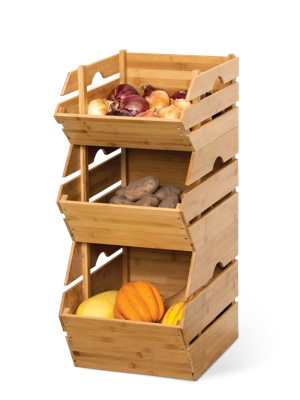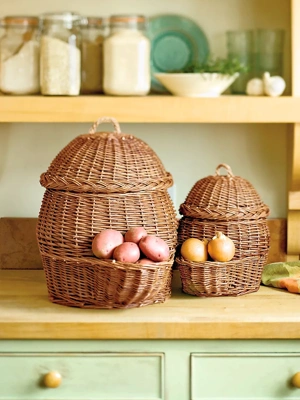Quick, Easy Techniques for Preserving the Harvest
Find yourself with more fresh vegetables than time?

One of the best parts of summer is having an abundance of fresh food from the garden. But that very abundance becomes stressful toward the end of the season when my before- or after-work strolls reveal perfectly ripe and delicious vegetables about to go to waste.
Some weeks I just can't find the time to can tomatoes, make a batch of salsa or chili, or make jelly, jam or pickles. Maybe I should plant a smaller garden, you say? Well … I can't. I could probably skip the eggplant and tomatillos and Swiss chard altogether, but they're like old friends. I'm always glad to see them and I'd miss their distinctive form and leaves and flowers and fruit. I could surely get by without so many tomato and pepper plants, but they are so robust and so generous and so happy in my garden that come spring I just can't reduce the number I plant.
If you, too, find yourself with more vegetables than time, here are a few of the super-quick, after-work solutions that I use to save some of summer's bounty for cold winter days.
Peppers
To preserve peppers for winter stir-fries, salads and sandwiches, all you need is a little extra space in the back of your freezer or refrigerator. I preserve both sweet and hot peppers, and the methods described below work well for either type.
Just a note of caution: When you're working with hot peppers, make sure to wear a pair of rubber gloves. I rarely wear garden gloves and never wear dishwashing gloves, but I learned the hard way that when it comes to hot peppers, gloves are a necessity. Several years ago I cored and sliced up a few pounds of hot peppers without wearing gloves and my hands burned for two days straight. Now I keep a special pair of gloves under the kitchen sink just for chopping hot peppers.
To freeze peppers: Halve sweet peppers (green, red, yellow or purple), remove the core and seeds, and slice into julienne strips or small 1/4" chunks. Pack them into a freezer bag, squeeze out the air and throw them in the freezer. That's it! Frozen peppers are best used in a dish that gets sauteed, such as a stir-fry, or added to onions and potatoes for a tasty omelet.
To pickle peppers: Prepare peppers as above. Fill a clean pint or quart jar to within an inch of the top with the chopped peppers. Pour in white vinegar to cover all peppers. Cover with a plastic lid if possible, as the vinegar will gradually corrode metal lids. Store the jar in the back of your refrigerator for up to 12 months. The peppers will stay crunchy for a few months but will gradually soften. Spoon them out of the jar as you need them. The vinegar is flavorful, too. My favorite pickled peppers are a colorful mix of yellow, orange and red Hungarian hot wax peppers. They're great on sandwiches or mixed into pasta and bean salads.
Tomatoes
Frozen tomatoes can't compare with those that have been canned. But if you don't have the time or equipment for canning, you can still put away some tomatoes to enjoy on a snowy evening when summer is just a memory. My neighbor freezes her tomatoes whole. She just sticks them in a plastic bag and throws them in the freezer. When you want some tomatoes for cooking, just hold a frozen tomato under running water and the skin slips right off. These work well in soups and sauces.
If you've grown paste tomatoes, you can cut off the top of each tomato and give them a quick squeeze to eject most of the seeds and clear liquid. Then you can either puree the tomatoes in a food processor and freeze the puree raw in a freezer bag, or — if you have a food dehydrator — cut the tomatoes in half and dry them until they're a bit drier than an apricot. Then either put them into a freezer bag and keep them in the freezer, or stick them in a jar and cover with olive oil or canola oil. Keep the jar in the back of your refrigerator.

Herbs
I use two quick methods to preserve herbs, depending on the type of herb.
For basil, parsley, cilantro and mint, remove the stems and run each herb (separately!) through your food processor. Add a little oil to coat the leaves, then pack them into a freezer bag. Press the bag flat like a pancake so it's easy to break off chunks as needed.
For sage, tarragon, thyme, bay, oregano, rosemary, bundle a small clump of herbs together with a rubber band and hang them to dry in a dark, warm, dry area. When the leaves are dry, gently remove them from the stems and put the leaves into jars. Store away from sunlight.
Beets and Carrots
If you can spare a crisper drawer, you can enjoy your homegrown beets and carrots until December or even January. After you pick the carrots, remove the green tops. For the beets, use a scissors to remove all but 1" of tops. Rub off loose soil but don't wash them or allow them to dry out. Put the carrots and beets into separate plastic bags and put the bags into a crisper drawer in your refrigerator. Don't seal the bags tightly. A little air circulation is good. Also, don't store near apples because they will cause the vegetables to soften. Check monthly.

Berries and Other Fruit
Most berries, such as blueberries, raspberries and blackberries, can be frozen whole. Cherries should be pitted first. Just pop any of these into a freezer bag. Strawberries, peaches and similar fruits should get sliced and then sprinkled with a little sugar. Let stand 30 minutes to create a protective sugar/juice glaze, then pack the slices into freezer bags.
Onions, Potatoes and Winter Squash
If you've grown some of these easy keepers, you'll find storage techniques in the article How to Grow and Store Potatoes, Onions, Garlic and Squash.
Share the Wealth
Your coworkers, neighbors and local food shelf will always be eager to take fresh vegetables off your hands. One spring, I had an abundance of asparagus and didn't have time to prepare and freeze the soup that's usually a winter staple at my house. So I just cut the spears before work, stuck them in a plastic bag and brought them to the office. I rarely made it from the car to the front entrance before someone would eagerly take the asparagus off my hands. You get to increase your popularity while making your after-work strolls through the garden much more relaxing.
Last updated: 01/04/2023
Print this Article:
Related items
Get the Dirt
Stay up to date on new articles and advice. Please fill out the information below.








